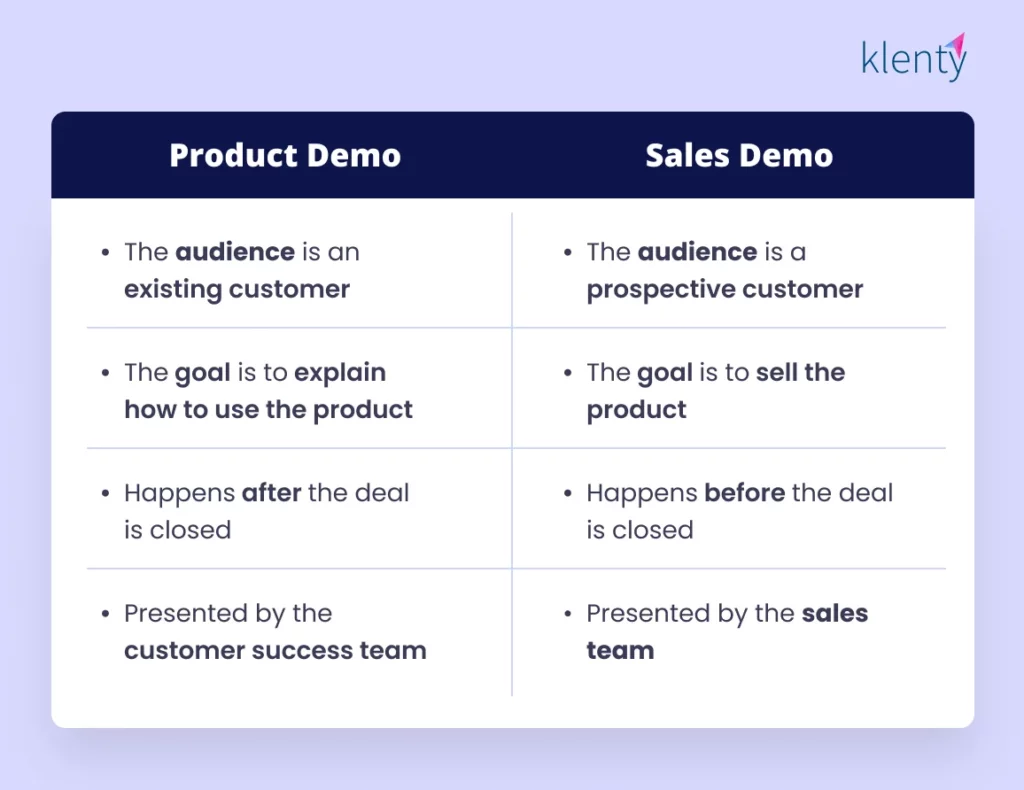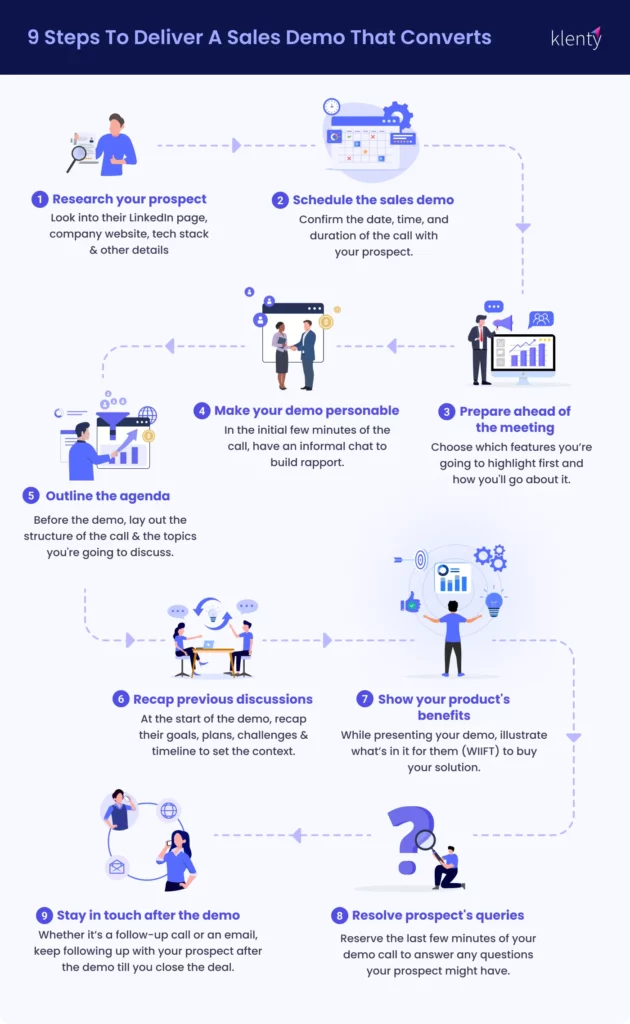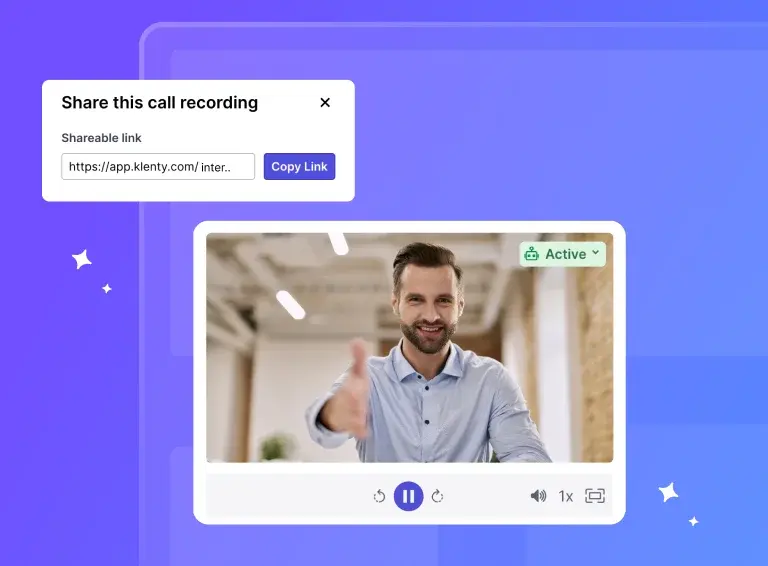A sales demo determines whether you close or lose the deal.
From ensuring a healthy pipeline of opportunities to giving that final push to prospects to put pen to paper, a good sales demo is where it’s at.
But what does it take to deliver a good demo? How can your demos convince prospects that your product is the right solution for their pain points? What are the steps in presenting your sales demo? And what not to do before, during, and after demos?
Here, we’re going to break down everything you need to know—what makes a good sales demo, steps in the demo process, best practices, and how top sellers who smash massive numbers deliver their demos.
But first, let’s start with the basics.
What Is a Sales Demo?
Sales demo, which is an abbreviation of sales demonstration, is the visual presentation of a product made by a seller to a potential buyer.
The presentation would be based on the previous conversations the sales rep had with the prospect. It typically covers the product’s features, capabilities, and how it would exactly solve their pain points and be of value to them.
The goal of giving any sales demo is to successfully close the deal by convincing the prospect.
According to sales leader Chris Orlob, the most important part of any sales demo is its relevance in addressing the prospect’s pain points. “Your demo should exactly solve your customer’s business problem. No less. But, also, no more.”
What Is the Difference Between a Product Demo and a Sales Demo?
As the name suggests, both sales demo and product demo involve presenting the product.
So, are these two the same? Or are they worlds apart?
Yes, the context and the audience differ for both. Find out the difference below:

Getting To Know Sales Demos Better
Now that you have a better picture of what a sales demo is, let’s delve deeper into the different aspects—the who, why, when, what, and how—of a demo.
Who’s the One Giving the Sales Demo?
In most organizations, the sales reps—more specifically, the account executives—present the demos to prospects.
Why Offer a Sales Demo?
The goal of any sales demo is to close the deal by convincing the prospect to purchase the solution. The path to this goal is laying out before prospects exactly how your solution would solve their problems and why they should choose you over a competitor.
Presenting sales demos is one of the stages of the B2B sales cycle. So, essentially, sales cannot continue without demos. A well-presented sales demo tailored to the prospect’s pain points and priorities can be a powerful way of influencing their decision to sign up for your product.
When Do You Carry Out a Sales Demo?
Sales demos typically occur after prospects agree to come to a meeting to check out the solution. Usually, the rep would ask a few questions about the prospect’s problems and aspirations in a process known as sales discovery. Following the discovery process, the rep presents the demo.
How Do You Deliver a Sales Demo?
Demos are commonly presented live through video calls using platforms like Zoom. During the call, the rep shares either the screen with the prospects to show the software in real time or a deck prepared to highlight a particular feature.
Sometimes, the demos could also be a pre-recorded video walkthrough or an interactive automated demo video.
What’s the Duration of a Sales Demo?
The duration of any sales call, let alone a demo call, can differ from one sales rep to another and based on the prospect’s preferences.
A sales demo call usually lasts 30 minutes to one hour. Some sales teams prefer to club discovery and demo calls together, while others prefer to have separate calls for discovery and demo.
9 Steps To Deliver a Sales Demo That Converts
A good sales demo, sales leader Pete Prowitt says, should be “engaging, relevant, and include at least a few ‘aha!’ moments'' for your prospect.
But how do you get there? By following these 9 steps:

1. Research Your Prospect
The bedrock of all sales calls is researching your prospects well. Knowing as much as you can about them helps you to tailor your demo to them specifically and build a strong rapport.
But what kind of information are we talking about here? That’d vary depending on your ICP and your industry, but here are 2 approaches to pre-call research you can use:
- The first is suggested by sales director Florin Tatulea. He blocks 30 minutes before a demo call to research:
- The prospect’s LinkedIn page
- Their company’s website
- The tech stack they’re using
- Articles about their company and CEO
- If you’re hard-pressed for time because you might have multiple demos in a day, follow Kyle Coleman’s 5x5 method. This involves blocking just 5 minutes before the call to find out 5 things about the prospect, like:
- Team or company growth trends
- Alma mater and college major
- Sports interests
- Regional interests
- Funding or VC portfolio
2. Schedule the Sales Demo
Since a demo call is always planned in advance, communicate with the prospects the date, time, and duration of the call via email to check if the time works with your prospect. Once you get the okay from them, send a calendar invite and schedule the demo accordingly.
Also, check with the prospect on whether they’d be participating alone or with others in the team. In that case, email the invite to all the participants. Also, follow up with a confirmation email a few hours before the demo to confirm their attendance.
3. Prepare Your Sales Demo Ahead of the Meeting
As with everything else, preparation is key to the success of your sales demo. Here are the 3 steps for a winning pre-call prep:
- Fixing the sequence. Based on your research on the prospect and notes from your discovery conversation, decide the sequence of your demo. Choose which features of your product you’re going to highlight first as per the pain points, how you're going to explain each feature and the duration you'd spend per feature.
- Checking support materials. Apart from these, check if the webpages and decks you’re planning to open during the demo are ready and working.
- Plan to engage everyone. If it’s going to be a group demo (having 2 or more persons from the prospect’s organization on the call), prepare how you’re going to engage all of them. It could be as simple as naming each of the prospects in frequent intervals, so ensure you know their names, roles, and how to pronounce their names correctly.
4. Make Your Sales Demo Personable
Yes, you’re trying to sell your product through the demo. But don’t forget you’re selling to a person. Would you prefer a sales rep who's pushy and obnoxiously salesy? Or someone who builds strong rapport by knowing what exactly you want?
As the saying goes, do to others what you would have them do to you. In the initial few minutes of the call, have a casual and light-hearted chat with your prospect before moving to the demo. You can share personal anecdotes or ask what they did over the weekend. But be careful not to overstep any professional boundaries.
By building a strong rapport this way, you boost the chances of closing the deal. Even if you lose the deal, the prospect might come back to you because of the rapport you've built.
5. Outline Sales Demo Agenda
During the initial rapport-building conversation, it’s best to lay out a clear agenda for the demo call to set your prospect’s expectations. State the structure of the call and the topics to be discussed in each section.
For example, an agenda for an hour-long demo call would look something like this:
- 30 minutes for discovery and rapport-building
- 15 minutes for the demo
- 15 minutes for a Q&A session and discussing next steps.
6. Recap Previous Discussions
To have a smooth segue into your sales demo, it’s best to have a small recap of your previous discussions, like the discovery process, and give some context into what they’re going to see.
You can follow one of these frameworks:
- Goals, Plans, Challenges, Timeline (GPCT): Summarize the prospect’s goals for their company, how they’re currently planning to achieve the goals, the challenges they’re facing in achieving their goals, and their timeline to reach these goals. Once they confirm that your outline is correct, you can provide context to the demo by tying these points to your product and proceeding to the demo.
- Situation, Complication, Resolution (SCR): Talk about the prospect’s current situation, the complications they’re facing in their processes, and how your product can help in the resolution. The last part will help you segue smoothly into the demo.
7. Show the Benefits of Your Product
Now, the time for which you worked so hard has come—presenting the demo to the prospect.
The rule of thumb for a strong demo is feature-benefit selling. This means showing your product’s value by connecting its features to the prospect’s pain points and goals. In other words, you need to clearly show what’s in it for them (WIIFT) to buy your solution.
Why does this battle-seasoned approach work? Because it’s based on the eternal sales truth: People buy with emotions and justify with logic. Features appeal to just the logic of your prospects, but the benefits appeal to their emotions.
So, when 95% of the purchasing decisions are subconsciously made, rattling out a bunch of features during the demo instead of showing to how your product would help them achieve their goals can’t be a good strategy to convince your prospective customer.
To further strengthen your appeal to the prospect’s emotions during the demo, harness the power of storytelling to make your selling come alive. Narrate the journey of how your solution can take your prospect from where they are to where they want to be with the help of the solution’s benefits.
This way, you’ll establish an emotional connection with the prospect, thereby increasing the likelihood of them signing up for your product.
8. Resolve Queries That Prospect Might Raise
Reserve the final few minutes of your demo call to answer any questions that the prospect might have after watching your demo.
They might have questions about certain existing features or might raise objections about pricing or competitors. Answer them tactfully in the same call, or schedule a sales demo follow-up if you feel your explanation might exceed the scheduled call duration.
If the prospect remains too silent during and after the demo, ask tie-down questions like “Just curious, how are you executing {process} right now?” or “Do you mind if I ask what you think about {a piece of information you shared}?” that encourages them to reveal more information.
9. Keep in Touch With Your Prospect After the Demo
Your demo call might have ended, but the deal is yet to be closed. Whether it’s a follow-up call to discuss pricing or a follow-up email to share a sales deck, articulate the next steps to the prospect.
As you might know, 80% of sales happen after 5 follow-ups. So, don’t take following up after the demo for granted, and stay in constant contact with your prospect till they sign the contract and the deal becomes a closed-won.
Sales Demo Best Practices
Curious about how to give a good sales demo and some best practices followed by successful reps? Look no further.
We asked 5 quota-smashing closers to break down their selling process and curated their responses in the Closers X Factor series. Here are 5 approaches for sales demos that they use to convince their prospects and close deals successfully.
1. Lead With Value, Not With Features
Qayam Noorani, whose quota attainment was a whopping 187% in Q4 2022, says he always leads with values in his demos and never with features.
When showing the relevant parts of his solution, he doesn’t describe the feature but explains the value the prospects will get from it. For each feature, he talks about:
- Why does it exist?
- What problems does it solve?
- How does it relate to the prospect’s pain points?
Wisdom nugget: "Come into the call, spend some time validating the prospect’s challenges, goals, timelines, and then show them exactly what they need to see. No more, no less. And you'll have a successful meeting."
2. Don’t Flood Prospects With Information
A closer who hit 100% quota for 2 years in a row, Kevin Deldjoui is a practitioner of exactitude in his demos. He shows only the features that will help prospects achieve their goals and are related to the initiatives they’re currently working on.
Reps might feel the temptation to oversell, especially if the prospect reacts positively to the demo. But this can be detrimental to your sales goals, he says, as prospects might feel flooded if they’re shown features they don’t need immediately.
Wisdom nugget: “Sometimes, you need to just stop selling. It's sold, and everything else is just a nice-to-have. You solved what they needed to do. So, just briefly mention the other stuff and say, ‘We can go into it if you want to.’”
3. Show, Articulate, Ask
Named as one of the top 25 AEs to follow on LinkedIn as per a survey, Jan Benedikt Mundorf follows a simple but effective 3-step formula to make his demos a success:
- Show only relevant features to the prospect.
- Articulate the product value by explaining what these features mean to them.
- Ask a gap question like, “Compared to what you're having right now, how would this feature help you better in your day-to-day decisions?”
Wisdom nugget: “That's the difference between an average sales rep, and then the top AEs, because they come across as trusted advisors, who help solve the customer’s project."
4. Don’t Negotiate Right After Demo
Varshni Gurumoorthy, who hit 107% quota in January 2023, begins her demos with her product’s feature that meets the prospect’s high-priority use case, completing which she goes to the rest of the features in the sales demo process.
Although Varshni discusses pricing at the end of her demos, she does not negotiate immediately in the same call. As the prospects have just seen how the product looks and how much it costs, she asserts that its value must seep well for them to decide.
Wisdom nugget: “I like to give the buyers that time to digest."
5. Clearly Outline the Next Steps
A rep boasting 109% quota attainment for Q1 2023, Akshaya Sampath credits her sales success to her ability to outline the next steps post-demo clearly.
Once the demo’s over, Akshaya directly asks the prospects what the next steps after the call should look like. If the prospect replies that they must think about it, she’ll tell them, “Typically, this is what we do,” and explain her usual next steps.
If they do have an idea of the next steps, like discussing with their team or leadership, she ensures to get a date and time on the calendar from them to schedule a call.
Either way, she gets a specific date and time from the prospect by the end of the call to schedule another call. This helps her to prevent getting ghosted after the demo.
Wisdom nugget: "There is no, ‘You know what? I'll get back to you.’ I’m like, ‘Okay, you can get back to me, but I'm gonna put a time hold on my calendar right now.’ I lay out clear next steps."
How Call IQ Can Help You Deliver Winning Demos?
Most sales demos happen through video conferencing platforms like Zoom, Microsoft Teams, or Google Meet.
If you’re looking to improve the quality of your sales demos, looking back at your previous demos can be a good place to start. This way, you'll understand where your strengths lie and where you could improve.
You need a summary of the call and insights like questions asked by the prospect, pain points and goals discussed, any competitor mentions, what features were discussed, and the next action items.
Sales reps and managers can choose to listen to entire recordings to get these insights. But spending hours listening to dozens of calls every day on top of your existing tasks is just plain impossible.
Call IQ is a conversation intelligence platform built to solve this problem.
With Call IQ, you will have:
- AI-driven summaries: With Call IQ, you get 4 different call summaries to help you get the maximum out of each call. Spotlight Summaries highlights important moments of a call, Action Items gives the next steps discussed during the call, Questions Asked records all questions asked by prospects, and Sentiments separates positive and negative sentiments.
- Talk time tracking: Call IQ shows the talk time of each speaker in the call, making it easier to check if there was a good back-and-forth between the rep and the prospect throughout the call.
- Centralized location for calls: Call IQ offers a centralized location to store all your audio and video calls across Zoom, MS Teams, Google Meet, and Klenty Dialer, so you can look up any call any time.
- Automatic CRM update: Call IQ automatically saves your transcripts, summaries, and analytics to your CRM so that you can focus on conversations without the note-taking distractions.
Start your free trial for Klenty’s Call IQ today and present terrific demos that effortlessly take deals to closed-won!
Resources You'll Love
FAQs:
How do you give a good sales demo?
What is a demo call in sales?
How do you structure a demo?
● 30 minutes for discovery and rapport building
● 15 minutes for the demo
● 15 minutes for a Q&A session and discussing next steps.





